12.1: Vitamin D
- Page ID
- 40993
\( \newcommand{\vecs}[1]{\overset { \scriptstyle \rightharpoonup} {\mathbf{#1}} } \)
\( \newcommand{\vecd}[1]{\overset{-\!-\!\rightharpoonup}{\vphantom{a}\smash {#1}}} \)
\( \newcommand{\dsum}{\displaystyle\sum\limits} \)
\( \newcommand{\dint}{\displaystyle\int\limits} \)
\( \newcommand{\dlim}{\displaystyle\lim\limits} \)
\( \newcommand{\id}{\mathrm{id}}\) \( \newcommand{\Span}{\mathrm{span}}\)
( \newcommand{\kernel}{\mathrm{null}\,}\) \( \newcommand{\range}{\mathrm{range}\,}\)
\( \newcommand{\RealPart}{\mathrm{Re}}\) \( \newcommand{\ImaginaryPart}{\mathrm{Im}}\)
\( \newcommand{\Argument}{\mathrm{Arg}}\) \( \newcommand{\norm}[1]{\| #1 \|}\)
\( \newcommand{\inner}[2]{\langle #1, #2 \rangle}\)
\( \newcommand{\Span}{\mathrm{span}}\)
\( \newcommand{\id}{\mathrm{id}}\)
\( \newcommand{\Span}{\mathrm{span}}\)
\( \newcommand{\kernel}{\mathrm{null}\,}\)
\( \newcommand{\range}{\mathrm{range}\,}\)
\( \newcommand{\RealPart}{\mathrm{Re}}\)
\( \newcommand{\ImaginaryPart}{\mathrm{Im}}\)
\( \newcommand{\Argument}{\mathrm{Arg}}\)
\( \newcommand{\norm}[1]{\| #1 \|}\)
\( \newcommand{\inner}[2]{\langle #1, #2 \rangle}\)
\( \newcommand{\Span}{\mathrm{span}}\) \( \newcommand{\AA}{\unicode[.8,0]{x212B}}\)
\( \newcommand{\vectorA}[1]{\vec{#1}} % arrow\)
\( \newcommand{\vectorAt}[1]{\vec{\text{#1}}} % arrow\)
\( \newcommand{\vectorB}[1]{\overset { \scriptstyle \rightharpoonup} {\mathbf{#1}} } \)
\( \newcommand{\vectorC}[1]{\textbf{#1}} \)
\( \newcommand{\vectorD}[1]{\overrightarrow{#1}} \)
\( \newcommand{\vectorDt}[1]{\overrightarrow{\text{#1}}} \)
\( \newcommand{\vectE}[1]{\overset{-\!-\!\rightharpoonup}{\vphantom{a}\smash{\mathbf {#1}}}} \)
\( \newcommand{\vecs}[1]{\overset { \scriptstyle \rightharpoonup} {\mathbf{#1}} } \)
\( \newcommand{\vecd}[1]{\overset{-\!-\!\rightharpoonup}{\vphantom{a}\smash {#1}}} \)
\(\newcommand{\avec}{\mathbf a}\) \(\newcommand{\bvec}{\mathbf b}\) \(\newcommand{\cvec}{\mathbf c}\) \(\newcommand{\dvec}{\mathbf d}\) \(\newcommand{\dtil}{\widetilde{\mathbf d}}\) \(\newcommand{\evec}{\mathbf e}\) \(\newcommand{\fvec}{\mathbf f}\) \(\newcommand{\nvec}{\mathbf n}\) \(\newcommand{\pvec}{\mathbf p}\) \(\newcommand{\qvec}{\mathbf q}\) \(\newcommand{\svec}{\mathbf s}\) \(\newcommand{\tvec}{\mathbf t}\) \(\newcommand{\uvec}{\mathbf u}\) \(\newcommand{\vvec}{\mathbf v}\) \(\newcommand{\wvec}{\mathbf w}\) \(\newcommand{\xvec}{\mathbf x}\) \(\newcommand{\yvec}{\mathbf y}\) \(\newcommand{\zvec}{\mathbf z}\) \(\newcommand{\rvec}{\mathbf r}\) \(\newcommand{\mvec}{\mathbf m}\) \(\newcommand{\zerovec}{\mathbf 0}\) \(\newcommand{\onevec}{\mathbf 1}\) \(\newcommand{\real}{\mathbb R}\) \(\newcommand{\twovec}[2]{\left[\begin{array}{r}#1 \\ #2 \end{array}\right]}\) \(\newcommand{\ctwovec}[2]{\left[\begin{array}{c}#1 \\ #2 \end{array}\right]}\) \(\newcommand{\threevec}[3]{\left[\begin{array}{r}#1 \\ #2 \\ #3 \end{array}\right]}\) \(\newcommand{\cthreevec}[3]{\left[\begin{array}{c}#1 \\ #2 \\ #3 \end{array}\right]}\) \(\newcommand{\fourvec}[4]{\left[\begin{array}{r}#1 \\ #2 \\ #3 \\ #4 \end{array}\right]}\) \(\newcommand{\cfourvec}[4]{\left[\begin{array}{c}#1 \\ #2 \\ #3 \\ #4 \end{array}\right]}\) \(\newcommand{\fivevec}[5]{\left[\begin{array}{r}#1 \\ #2 \\ #3 \\ #4 \\ #5 \\ \end{array}\right]}\) \(\newcommand{\cfivevec}[5]{\left[\begin{array}{c}#1 \\ #2 \\ #3 \\ #4 \\ #5 \\ \end{array}\right]}\) \(\newcommand{\mattwo}[4]{\left[\begin{array}{rr}#1 \amp #2 \\ #3 \amp #4 \\ \end{array}\right]}\) \(\newcommand{\laspan}[1]{\text{Span}\{#1\}}\) \(\newcommand{\bcal}{\cal B}\) \(\newcommand{\ccal}{\cal C}\) \(\newcommand{\scal}{\cal S}\) \(\newcommand{\wcal}{\cal W}\) \(\newcommand{\ecal}{\cal E}\) \(\newcommand{\coords}[2]{\left\{#1\right\}_{#2}}\) \(\newcommand{\gray}[1]{\color{gray}{#1}}\) \(\newcommand{\lgray}[1]{\color{lightgray}{#1}}\) \(\newcommand{\rank}{\operatorname{rank}}\) \(\newcommand{\row}{\text{Row}}\) \(\newcommand{\col}{\text{Col}}\) \(\renewcommand{\row}{\text{Row}}\) \(\newcommand{\nul}{\text{Nul}}\) \(\newcommand{\var}{\text{Var}}\) \(\newcommand{\corr}{\text{corr}}\) \(\newcommand{\len}[1]{\left|#1\right|}\) \(\newcommand{\bbar}{\overline{\bvec}}\) \(\newcommand{\bhat}{\widehat{\bvec}}\) \(\newcommand{\bperp}{\bvec^\perp}\) \(\newcommand{\xhat}{\widehat{\xvec}}\) \(\newcommand{\vhat}{\widehat{\vvec}}\) \(\newcommand{\uhat}{\widehat{\uvec}}\) \(\newcommand{\what}{\widehat{\wvec}}\) \(\newcommand{\Sighat}{\widehat{\Sigma}}\) \(\newcommand{\lt}{<}\) \(\newcommand{\gt}{>}\) \(\newcommand{\amp}{&}\) \(\definecolor{fillinmathshade}{gray}{0.9}\)Vitamin D is unique among the vitamins in that it is part vitamin, part hormone. It is considered part hormone for two reasons: (1) we have the ability to synthesize it, and (2) it has hormone-like functions. The amount synthesized, however, is often not enough to meet our needs. Thus, we need to consume this vitamin under certain circumstances, meaning that vitamin D is a conditionally essential micronutrient.
Query \(\PageIndex{1}\)
There are two major dietary forms of vitamin D: the form produced mainly by plants and yeast is vitamin \(D_2\) (ergocalciferol), and the form mainly made by animals is vitamin \(D_3\) (cholecalciferol). The main terms in the previous sentence are because lichens, a symbiotic relationship between 2 bacteria and a fungus, are able to synthesize vitamin \(D_3\), and are being utilized some now commercially as described in the following article.
The structures of these two forms are shown below. Notice that the only difference is the presence of a double bond in \(D_2\) tail that is not in \(D_3\).
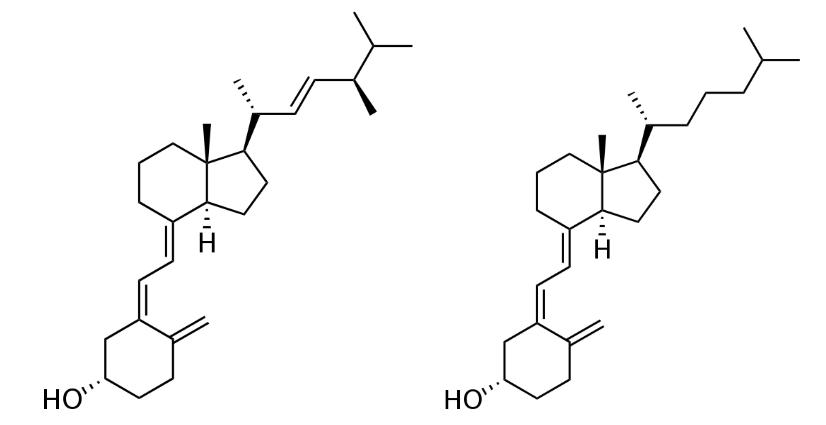
We synthesize vitamin \(D_3\) from cholesterol, as shown below. In the skin, cholesterol is converted to 7-dehydrocholesterol. In the presence of UV-B light, 7-dehydrocholesterol is converted to vitamin \(D_3\). Synthesized vitamin D will combine with vitamin D-binding protein (DBP) to be transported to the liver. Dietary vitamin \(D_2\) and \(D_3\) is transported to the liver via chylomicrons and then taken up in chylomicron remnants. Once in the liver, the enzyme 25-hydroxylase (25-OHase) adds a hydroxyl (\(\ce{-OH}\)) group at the 25th carbon, forming 25-hydroxy vitamin D (25(\(\ce{OH}\))D, calcidiol). This is the circulating form of vitamin D, thus 25(\(\ce{OH}\))D blood levels are measured to assess a person's vitamin D status. The active form of vitamin D is formed with the addition of another hydroxyl group by the enzyme 1alpha-hydroxylase (1alpha-OHase) in the kidney, forming 1,25 hydroxy vitamin D (1,25(\(\ce{OH}\))2D). The synthesis and activation of vitamin D is shown in the figures below.



However, there are a number of other tissues that have been found to have 1alpha-hydroxylase activity. Therefore, these tissues can activate circulating 25(\(\ce{OH}\))D to 1,25(\(\ce{OH}\))2D for their own use.
Vitamin \(D_2\) and \(D_3\) were once thought to be equivalent forms of vitamin D, but research has found that \(D_3\) supplementation increases 25(\(\ce{OH}\))D concentrations more than \(D_2\) supplementation7,8.
Query \(\PageIndex{2}\)
Query \(\PageIndex{3}\)
Query \(\PageIndex{4}\)
Query \(\PageIndex{5}\)
Environmental Factors That Impact Vitamin D3 Synthesis
There are a number of environmental factors that affect vitamin \(D_3\) synthesis:
Latitude
The latitude a person is at affects that person's ability to synthesize vitamin \(D_3\). There is an inverse relationship between distance from the equator and UV light exposure. Thus, with increased distance from the equator (increased latitude), there is decreased UV light exposure and vitamin \(D_3\) synthesis. The link below shows the latitude and longitude lines of the United States.
Seasons
Seasons also make a difference in vitamin \(D_3\) synthesis. In Boston (42० N), vitamin D synthesis only occurs from March-October, because during late fall and winter not enough UV-B reaches the earth's surface to synthesize vitamin \(D_3\). However, in Los Angeles (34० N), vitamin \(D_3\) synthesis occurs year round10. The difference is the angle of the sun relative to latitude and how many UV-B photons are absorbed before they reach the earth's surface9.

Time
Time of day is also an important factor in affecting vitamin \(D_3\) synthesis. Vitamin \(D_3\) synthesis increases in the morning before peaking at noon, then declines the rest of the day9.

Skin pigmentation
Another factor that plays an important role in vitamin \(D_3\) synthesis is skin pigmentation. Skin color is the result of increased production of the pigment melanin, as shown in the link below.

Very dark skin color can provide a sun protection factor (SPF) 8-30 for those individuals who never burn2. These individuals will require approximately 5- to 10-times greater sunlight exposure than light-skinned, white individuals to synthesize the same amount of vitamin \(D_3\)10,11.
Age
Age also plays a factor in vitamin \(D_3\) synthesis. Aging results in decreased 7-dehydrocholesterol concentrations in the skin, resulting in an approximately 75% reduction in the vitamin \(D_3\) synthesis capability by age 7011.

Clothing
Clothing is another factor that influences vitamin \(D_3\) synthesis. More clothing means that less sun reaches your skin, and thus less vitamin \(D_3\) synthesis.

Sunscreen, "Sensible Sun Exposure", and Tanning
There is quite a spirited debate on sunscreen, sun exposure, skin cancer, and vitamin D synthesis. On one side are the vitamin D researchers, on the other side are dermatologists. Older vitamin D research found that SPF 8 sunscreen almost totally blocked vitamin \(D_3\) synthesis12. However, more recent research as described in the article below suggests that it does occur even with sunscreen use.
However, the SPF value equals 1/(# photons that reaches your skin) meaning that SPF 30 means 1/30 UV photons reach your skin. Thus, vitamin \(D_3\) synthesis shouldn't be totally blocked. In addition, studies indicate that consumers apply 1/2 or less of the amount required to get the listed SPF protection4. Researchers recommend sun exposure on the face, arms, and hands for 10-15 minutes 2-3 times per week between 10 AM-3 PM10,13. However, dermatologists do not like "sensible sun exposure" because this is also the peak time for harmful sun exposure. Dermatologists say that "sensible sun exposure" appeals to those who are looking for a reason to support tanning and are at highest risk (primarily young, fair-skinned females) of sun damage. They argue that vitamin D can be provided through supplementation11.
What about tanning beds? Not all tanning beds provide UV-B rays that are needed for vitamin \(D_3\) synthesis. In fact, some advertise that they only use UV-A rays that are safer, even though this is not the case14. Virtually every health organization advises against using tanning beds, because the risks are far greater than the potential benefits14,15.
Query \(\PageIndex{6}\)
Query \(\PageIndex{7}\)
Dietary or Supplemental Vitamin D
Because of the possible double-edged sword of sun exposure for synthesizing vitamin \(D_3\), dietary or supplemental vitamin D is another alternative.
However, there are a limited number of foods naturally rich in vitamin D. Good sources of vitamin D are fatty fish (salmon, tuna, etc.) and their oils (such as cod liver oil). The amount of vitamin D in fatty fish varies greatly with wild-caught salmon being the highest. One study showed that farmed salmon contained almost 75% less vitamin D than wild-caught salmon16. It is not known whether this disparity exists between other types of farmed and wild-caught fish varieties.
| Fish | Vitamin D (IU/oz) |
|---|---|
| Blue Fish | 280 ± 68 |
| Cod | 104 ± 24 |
| Grey Sole | 56 ± 36 |
| Farmed Salmon | 240 ± 108 |
| Wild Salmon | 988 ± 524 |
| Farmed Trout | 388 ± 212 |
| Tuna | 404 ± 440 |
Like vitamin C, E, and A, international units (IU) are also used for vitamin D.
For vitamin D the conversions are:
1 ug of \(D_3\) = 40 IU
1 ug of 25-OH-D = 200 IU17
Thus, since not many foods contain vitamin D, cow’s milk has been voluntarily fortified with vitamin \(D_2\) or \(D_3\) (100 IU/8 oz) since the 1930s11. However, the actual measured amount of vitamin D in many brands of cow’s milk is far less than stated on their labels18,19. Part of this problem stems from a lack of a standardized method for measuring vitamin D in the past. Without standardized analysis, there inevitably was a wide range of variation from lab-to-lab in the reported amount of vitamin D.
Query \(\PageIndex{8}\)
Lactose Intolerance
Another issue with relying on dairy products to provide vitamin D is the common problem of lactose intolerance. Lactose intolerant individuals don't have lactase, the enzyme needed to break down lactose. Common symptoms of this condition include:
- Abdominal Pain
- Abdominal Bloating
- Gas
- Diarrhea
- Nausea20
Lactose intolerance is a fairly common problem worldwide, as shown in the map below.

The following table shows the percent of people who are lactose intolerant by race:
| Race or ethnicity | % Lactose Intolerant |
|---|---|
| Southeast Asian | 98% |
| Native Americans | 62-100%23 |
| Asian Americans | 90% |
| Alaskan Eskimo | 80% |
| African-American Adults | 79% |
| Mexicans (rural communities) | 74% |
| North American Jews | 69% |
| Greek Cypriots | 66% |
| Cretans | 56% |
| Mexican American Males | 55% |
| Indian Adults | 50% |
| African-American Children | 45% |
| Indian Children | 20% |
| Descendants of N. Europeans | 5% |
Thus, you can see that many people are lactose intolerant. Coincidentally, many of these people have darker pigmented skin, meaning that they have an increased risk of vitamin D deficiency/insufficiency because they require greater sun exposure to synthesize adequate amounts of vitamin \(D_3\).
Other foods that are sometimes fortified are breakfast cereals and orange juice. Despite the fact that orange juice doesn't contain fat, and vitamin D is fat-soluble, vitamin D is quite bioavailable in orange juice24.
Vitamin D in supplements is found as vitamin \(D_2\) or \(D_3\). However, based on the recent evidence suggesting that \(D_2\) isn't as beneficial as \(D_3\), many are being reformulated to contain \(D_3\)25.
Query \(\PageIndex{9}\)
Response to Low Blood Calcium
One of the major functions of vitamin D is to assist in maintaining blood calcium concentrations. The other major regulators of blood calcium concentrations are 2 hormones: parathyroid hormone (PTH) and calcitonin, which are released from the parathyroid glands and thyroid glands, respectively. Bone serves as the calcium depot, or reservoir, if there is a sufficient concentration in the body. In bone, calcium is found in hydroxyapatite crystals on a collagen matrix.
The chemical formula of hydroxyapatite is \(\ce{Ca10(PO4)6(OH)2}\).
Calcium and phosphorus are either jointly deposited (deposition) or jointly liberated (resorption) from bone hydroxyapatite to maintain/achieve blood calcium concentrations. Osteoblasts are bone cells that are responsible for bone formation or depositing hydroxyapatite. Osteoclasts are the bone cells that are responsible for breaking down or resorption of bone. An easy way to remember the function of these cells is:
- Osteoblasts "build" bone
- Osteoclasts "chew" bone
Bone resorption is the process of liberating calcium and phosphorus from hydroxyapatite. Bone deposition is the process of depositing calcium and phosphorus in bone as hydroxyapatite.
Query \(\PageIndex{10}\)
Response to Low Blood Calcium
The parathyroid senses low blood calcium concentrations and releases PTH. These steps are designed to maintain consistent blood calcium concentrations, but also affects phosphate (phosphorus) concentrations. PTH has 3 effects:
- Increases bone resorption
- Decreases calcium and increases phosphorus urinary excretion
- Increases 1,25(\(\ce{OH}\))2D activation in the kidney3,14
The first effect of PTH is increased bone resorption. Hydroxyapatite must be broken down to release both calcium and phosphate. This effect is illustrated below.
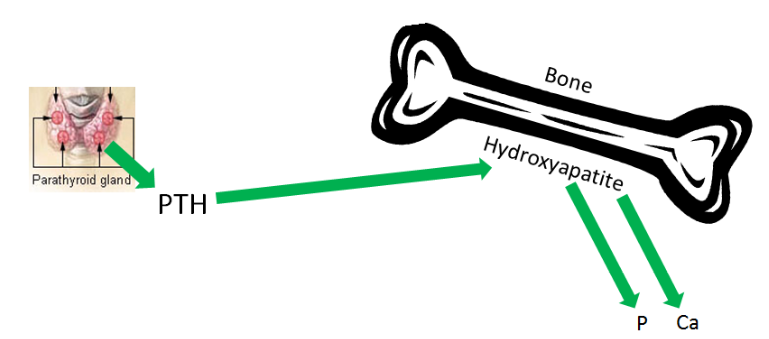
The second effect of PTH is decreased calcium excretion in urine. This is a result of increased calcium reabsorption by the kidney before it is excreted in urine. Kidney phosphate reabsorption is decreased, meaning the net effect is less calcium, but more phosphate in urinary excretion, as shown in the figure below.
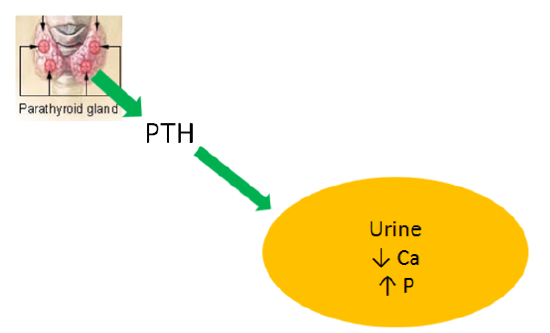
The 3rd effect of PTH is that it increases 1,25(\(\ce{OH}\))2D activation in the kidney, by increasing 1alpha-hydroxylase levels. The 1,25(\(\ce{OH}\))2D then increases calcium and phosphorus absorption in the small intestine to help raise blood calcium levels, as shown below. This mechanism will be discussed in more detail in the vitamin D receptor subsection.
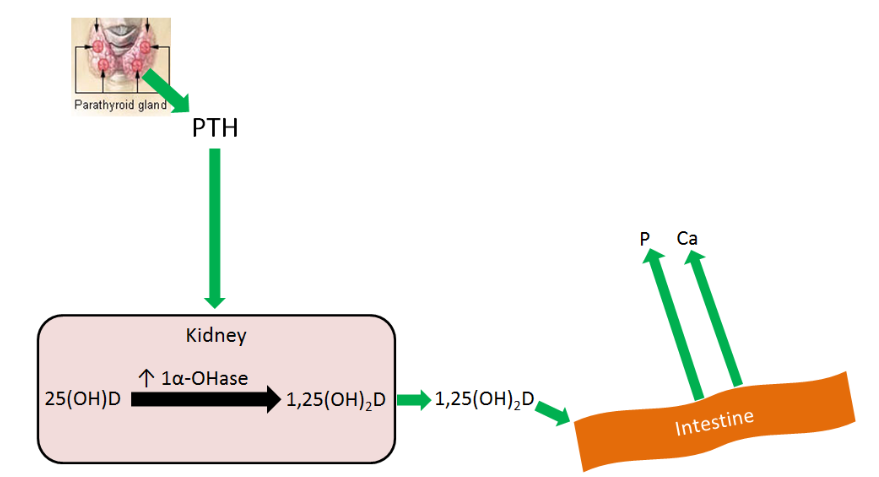
Overall PTH causes more calcium and phosphate to be leached from bone, and absorbed from the intestine into the blood. Coupled with decreased calcium and increased phosphate urinary excretion, means that blood calcium levels rise without a marked rise in phosphate levels, as depicted in the figure below.
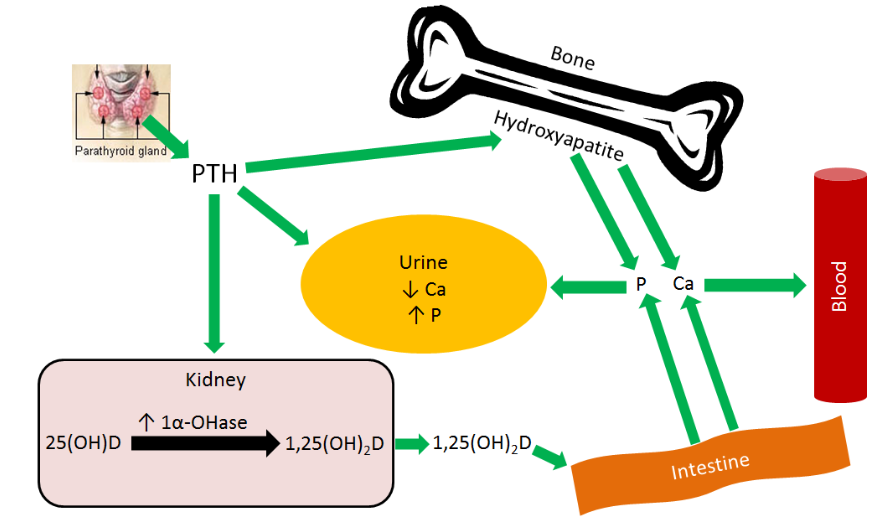
Query \(\PageIndex{11}\)
Response to High Blood Calcium
In adults, it is rare for blood calcium concentrations to get too high. However, in infants and young children whose bodies, and thus bones, are not as large, the hormone calcitonin helps to prevent blood calcium levels from getting too high3.
Response to High Blood Calcium
High blood calcium concentrations are sensed by the thyroid, which releases calcitonin. This response is designed to maintain/achieve normal blood calcium concentrations, but also affects phosphate (phosphorus) levels. Calcitonin has 3 effects3,14:
- Decreases bone resorption, increases bone deposition
- Increases calcium and phosphorus excretion in urine
- Decreases 1,25(\(\ce{OH}\))2D activation in the kidney
The first effect of calcitonin is to inhibit bone resorption, thus promoting the deposition of calcium and phosphorus into bone as hydroxyapatite.

The second effect of calcitonin is to increase calcium and phosphorus excretion in urine.
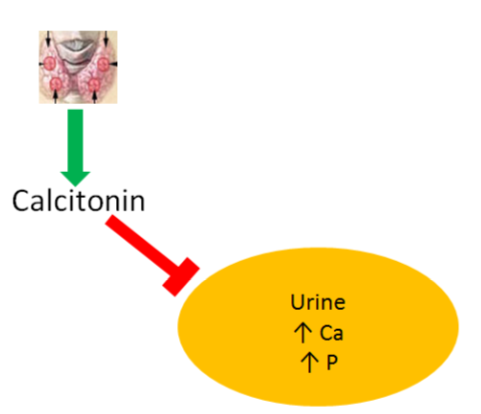
The third effect of calcitonin is to decrease 1alpha-hydroxylase levels, which decreases the activation of 1,25(\(\ce{OH}\))2D. As a result, the absorption of calcium and phosphorus from the small intestine is decreased, as shown below.

Overall, calcitonin inhibits the 3 actions that PTH uses to increase blood calcium levels. Thus, more calcium and phosphate are deposited into bones and excreted into urine as shown below. This causes blood calcium levels to decrease.
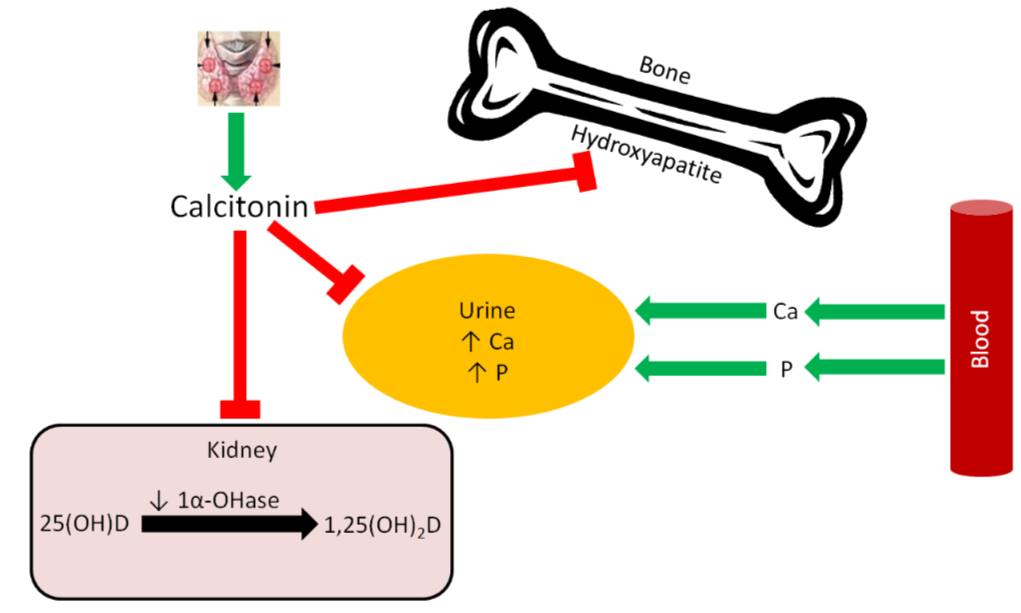
Query \(\PageIndex{12}\)
Vitamin D Receptor
Vitamin D, along with vitamin A, are unique among the vitamins in that they have nuclear receptors. Many steroid hormones have nuclear receptors. The following figure illustrates the action of a nuclear hormone receptor.
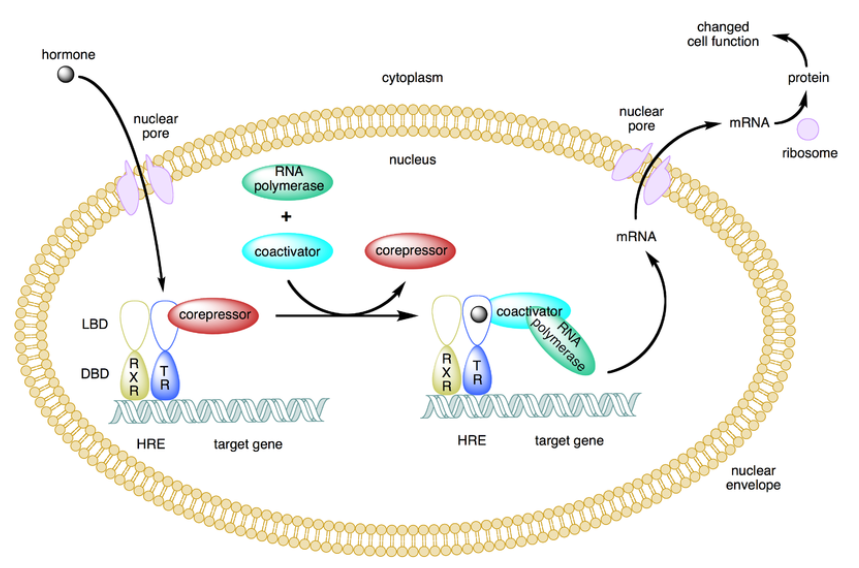
In the figure above of the hormone (in this case thyroid hormone) receptor, the receptor’s ligand (something that binds to the receptor), enters the nucleus and binds to the thyroid hormone receptor (TR). The TR has paired (formed a dimer) with the retinoid X receptor (RXR) on the hormone response element (HRE) in the promoter (region before a gene in the DNA sequence) of target genes. The HRE for thyroid hormone is the thyroid hormone response element. Target genes are those whose transcription is altered by the hormone binding to its receptor on the response element. The mRNA produced then leaves the nucleus where it is translated into protein.
Vitamin A and D have nuclear receptors that act in the same fashion as nuclear hormone receptors. The video below illustrates and explains the action of a nuclear hormone receptor.
Query \(\PageIndex{13}\)
1,25(\(\ce{OH}\))2D is considered to be the active form of vitamin D because it binds to the vitamin D receptor (VDR). Like the thyroid hormone example above, there is a vitamin D response element (VDRE) in the promoter of specific vitamin D target genes. In the figure below, 25(\(\ce{OH}\))D, the major circulating form of vitamin D, is usually transported through the blood to a target tissue by vitamin D binding protein (DBP). The kidney converts 25(\(\ce{OH}\))D to 1,25(\(\ce{OH}\))2D by use of the enzyme 1alpha-hydroxylase, but this enzyme is also found in other tissues to synthesize 1,25(\(\ce{OH}\))2D primarily for their own use (rather than secreting like the kidney). The latter scenario is what is being represented in the figure below. 1,25(\(\ce{OH}\))2D (bound to DBP) moves from the kidney, or the tissue itself, into the nucleus. It then binds to the vitamin D receptor (VDR), that is dimerized to the RXR on the vitamin D response element of the target gene. Consequently, this binding causes increased transcription of mRNA. The mRNA then moves into the cytoplasm to synthesize specific proteins. This process is shown in the figure below.

It's through this action that 1,25(\(\ce{OH}\))2D is able to increase calcium absorption. In this case, the target gene is the calcium-binding protein calbindin. Thus, increased 1,25(\(\ce{OH}\))2D leads to increased calbindin mRNA. This then leads to increased calbindin protein levels. Calbindin will be discussed in more detail in the calcium section.

Query \(\PageIndex{14}\)
Vitamin D Deficiency, Toxicity & Insufficiency
Rickets is a vitamin D deficiency condition in infants and children. A lack of vitamin D leads to decreased bone mineralization, causing the bones to become weak. The bones then bow under pressure, leading to the characteristic bowed legs, as seen below.


Another characteristic symptom of rickets is rachitic rosary, or beaded ribs. The beading occurs at the areas where cartilage meets bone on the rib cage, as shown in the link below14.
Web Link
Osteomalacia is a vitamin D deficiency in adults and results in poor bone mineralization. The bone becomes soft, resulting in bone pain and an increased risk of fractures14.
While rickets and osteomalacia are fairly rare in the United States, it is believed that vitamin D insufficiency might be much more widespread. Insufficiency means that the level of intake, or body status, is suboptimal (neither deficient nor optimal). The figure below illustrates this concept.

Suboptimal/insufficient means intake, or status, is higher than deficient, but lower than optimal. This is an important distinction to understand particularly for vitamin D, because there have been some (like Dr. Michael Holick described in the link below) saying the people are vitamin D deficient when their circulating 25(\(\ce{OH}\))D concentrations are lower than optimal. This is different from a classical deficiency definition, where there is a condition associated with too low level of intake or body status. What is really being described is that circulating 25(\(\ce{OH}\))D concentrations might be suboptimal. A lot of the debate about vitamin D deficiency is nicely captured in the article about Dr. Michael Holick, a prominent vitamin researcher.
Thus, higher intake levels will provide additional benefits. The functions of vitamin D are growing by the day due to increased research discoveries. These functions now include benefits beyond bone health, further supporting the importance of vitamin D. In late 2010, an RDA for vitamin D was established (was an Adequate Intake before). This made it, along with calcium, the first micronutrients to have their DRIs revised30. The RDA for vitamin D is 3 times higher than the previous AI. Many believe these are more reasonable levels, while others think that the new RDA is still not high enough. This belief, that many people’s vitamin D intake/status is suboptimal, is challenged by a review described in the first link below that found that vitamin D did not reduce osteoporosis risk. In addition, a recent meta-analysis (second link) concluded that “there is probably no benefit to expect from vitamin D supplementation in normally healthy people.”
Vitamin D from supplements can become toxic. You cannot develop vitamin D toxicity from sun exposure, because the sunlight degrades a precursor of vitamin \(D_3\) in the skin9. Vitamin D toxicity results in hypercalcemia or high blood calcium levels. These become problematic because it can lead to calcification of soft tissues.
Query \(\PageIndex{15}\)
Query \(\PageIndex{16}\)
References
- en.Wikipedia.org/wiki/File:Ergocalciferol.svg
- en.Wikipedia.org/wiki/File:Cholecalciferol.svg
- Gropper SS, Smith JL, Groff JL. (2008) Advanced nutrition and human metabolism. Belmont, CA: Wadsworth Publishing.
- commons.wikimedia.org/wiki/File:Liver.svg
- https://courses.lumenlearning.com/suny-nutrition/chapter/12-1-vitamin-d/
- https://courses.lumenlearning.com/suny-nutrition/chapter/12-13-response-to-low-blood-calcium/
- Lehmann U, Hirch F, Stangl GI, Hinz K, Westphal S, Dierkes J. (2013) Bioavailability of vitamin D2 and D3 in Healthy Volunteers, a randomized placebo-controlled trial. J Clin Endocrinol Metab. 98(11): 4339-4345.
- Tripkovic L, Wilson LR, Hart K, Johnsen S, de Lusignan S, Smith CP, Bucca G, Penson S, Chope G, Elliott R, Hypponen E, Berry JL Lanham-New SA. (2017) Daily supplementation with 15 μg vitamin D2 compared with vitamin D3 to increase wintertime 25-hydroxyvitamin D status in healthy South Asian and white European women: a 12-wk randomized, placebo-controlled food-fortification trial. Am J Clin Nutr 106 (2): 481-490.
- Shils ME, Shike M, Ross AC, Caballero B, Cousins RJ, editors. (2006) Modern nutrition in health and disease. Baltimore, MD: Lippincott Williams & Wilkins.
- Holick M. (2008) Vitamin D: A D-lightful health perspective. Nutr Rev 66(10 Suppl 2): S182.
- Stipanuk MH. (2006) Biochemical, physiological, & molecular aspects of human nutrition. St. Louis, MO: Saunders Elsevier.
- Gilchrest B. (2008) Sun exposure and vitamin D sufficiency. Am J Clin Nutr 88(2): 570S.
- Byrd-Bredbenner C, Moe G, Beshgetoor D, Berning J. (2009) Wardlaw's perspectives in nutrition. New York, NY: McGraw-Hill.
- Whitney E, Rolfes SR. (2011) Understanding nutrition. Belmont, CA: Wadsworth Cengage Learning.
- McGuire M, Beerman KA. (2011) Nutritional sciences: From fundamentals to food. Belmont, CA: Wadsworth Cengage Learning.
- Lu Z, Chen TC, Zhang A, Persons KS, Kohn N, et al. (2007) An evaluation of the vitamin D3 content in fish: Is the vitamin D content adequate to satisfy the dietary requirement for vitamin D? J Steroid Biochem Mol Biol 103(3-5): 642.
- Anonymous. (1997) Dietary reference intakes for calcium, phosphorus, magnesium, vitamin D, and fluoride. Washington, D.C.: National Academies Press.
- Holick MF, Shao Q, Liu WW, Chen TC. (1992) The vitamin D content of fortified milk and infant formula. New England Journal of Medicine, the 326(18): 1178.
- Faulkner H, Hussein A, Foran M, Szijarto L. (2000) A survey of vitamin A and D contents of fortified fluid milk in ontario. J Dairy Sci 83(6): 1210.
- digestive.niddk.nih.gov/ddise...seintolerance/
- commons.wikimedia.org/wiki/F...ntolerance.png
- nutrigenomics.ucdavis.edu/?pa...se_Intolerance
- McBean LD, Miller GD. (1998) Allaying fears and fallacies about lactose intolerance. J Am Diet Assoc 98(6): 671.
- Tangpricha V, Koutkia P, Rieke S, Chen T, Perez A, et al. (2003) Fortification of orange juice with vitamin D: A novel approach for enhancing vitamin D nutritional health. Am J Clin Nutr 77(6): 1478.
- https://ods.od.nih.gov/factsheets/Vi...hProfessional/
- en.Wikipedia.org/wiki/File:Il...arathyroid.jpg
- https://en.Wikipedia.org/wiki/Nuclear_receptor#/media/File:Type_ii_nuclear_receptor_action.png
- en.Wikipedia.org/wiki/File:Rickets_USNLM.gif
- en.Wikipedia.org/wiki/File:Xr...sLegssmall.jpg
- http://iom.nationalacademies.org/Rep...Vitamin-D.aspx


